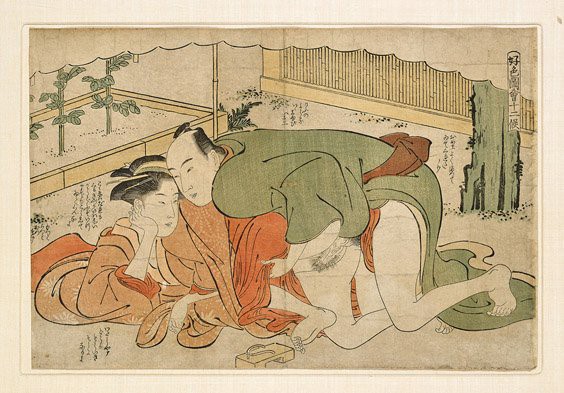Inexpensive Japanese Pornography

Hello, would you like to buy something weird? Hammer Time is our guide to things that are for sale at auction: fantastic, consequential and freakishly grotesque archival treasures that appear in public for just a brief moment, most likely never to be seen again.
During the Edo period in Japan, the lord of each province was required to spend six months out of the year in the capital. They were allowed to bring their families to Edo (present-day Tokyo), but more often than not, they were left behind.
In other words, lords got lonely.
There were an abundance of brothels, legalized by the shogunite, but also the sexually frustrated populace may have helped popularize shunga, or erotic art, as a masturbatory aid.
Historians now know that shunga was consumed far outside the capital, by men and women of every class. They valued the prints for more than just autoeroticism, or apart from it entirely; shunga could also be edifying and comical.
The prints were produced between the sixteenth and nineteenth century, sold as single sheets or in book form, called enpon. The print above is currently up for auction at I.M. Chait in Beverly Hills, with an estimate of $300 to $400. Josh Chait, director of operations, believes it was originally a part of a set. Modern day collectors frequently unbind books in order to individually display each print. It is signed; most shunga was not, for fear condemnation.
Shunga contained a kind of narrative, but not necessarily in a related or connected sequence. The point was variety, often to be instructive. Newlyweds might receive a copy on their wedding night, or the betrothed might have already utilized shunga as a study tool. The same book or series of prints could contain an octopus performing oral sex on one page, as in Hokusai’s famous “The Dream of the Fisherman’s wife,” followed by scenes of infidelity, the loss of virginity, masturbation, women seducing men, and men engaged in sexual acts together.
A good deal of shunga was written for a male audience, but there was a subgenre that focused on the fantasy of a door-to-door salesman, the kind who surreptitiously visits at night or during the day, when the “man of the house” is at work. Much like Patrick Dempsey’s pizza delivery boy in the 1989 movie Loverboy, fan-sellers appeared at the front doors of lonely housewives. Suzuki Harunobu, the first woodblock artist to work in full-color, used the opportunity to illustrate decorum with seduction. In an untitled print circa 1770, a young man’s sandals are conspicuously waiting on the stone patio outside the house, as it would be rude to enter the house with them; he is next seen seducing the wet nurse.
No matter what is depicted, shunga was an exploration of possibility during an otherwise culturally uptight period. The focus on sexuality during the Edo period was at odds with cultural norms, which was not lost on the artists, who often made an attempt to normalize the practice of voyeurism, assuaging any shame or guilt with illustrations or text.
Humor easily put readers at ease. In “Erotic Women in Ecstasy,” artist Tsukioka Settei plays with the ways traditional shunga fetishized women’s appearances. In “The Thirty-Two Areas of a Beautiful Woman,” Settei praises “the outline of her flower bud” — meaning the cartilage covering a women’s ear canal. Despite the evocative diction, art historians have compared the diagram itself to similar posters highlighting different cuts of meat.
Shunga featured courtesans and kabuki actors found in Yoshiwara, Edo’s pleasure district, but many focused on the working class, the merchants and farmers far outside the capital. The character’s sex was generally indecipherable from facial features alone, and they were almost always fully clothed, as communal baths rendered nudity a fairly unremarkable state.
The giveaway, however, is the “second face.” Artists drew exaggerated genitalia distinctly out of proportion with the rest of the body, with large, bulging veins and thick, sprouting hair.
In the absence of explicit images, text made the meaning clear. In a “Portrait of a Domestic Servant,” a seated man or woman is seen innocently drumming, but the left half of the image contains a comical haiku (translated to English):
For a dandelion
A little spit on the fingers
Helps
That, and the hair, likely pegs the subject as wakashū — a boy not yet a man. Enthusiasts would know that “dandelion” is simply a metaphor for anus.
Alexis Coe’s work has appeared in the Atlantic, Slate, The Millions, The Hairpin, SF Weekly, The Toast, and other publications. She holds an MA in history, and was a research curator at the New York Public Library. Follow her.
